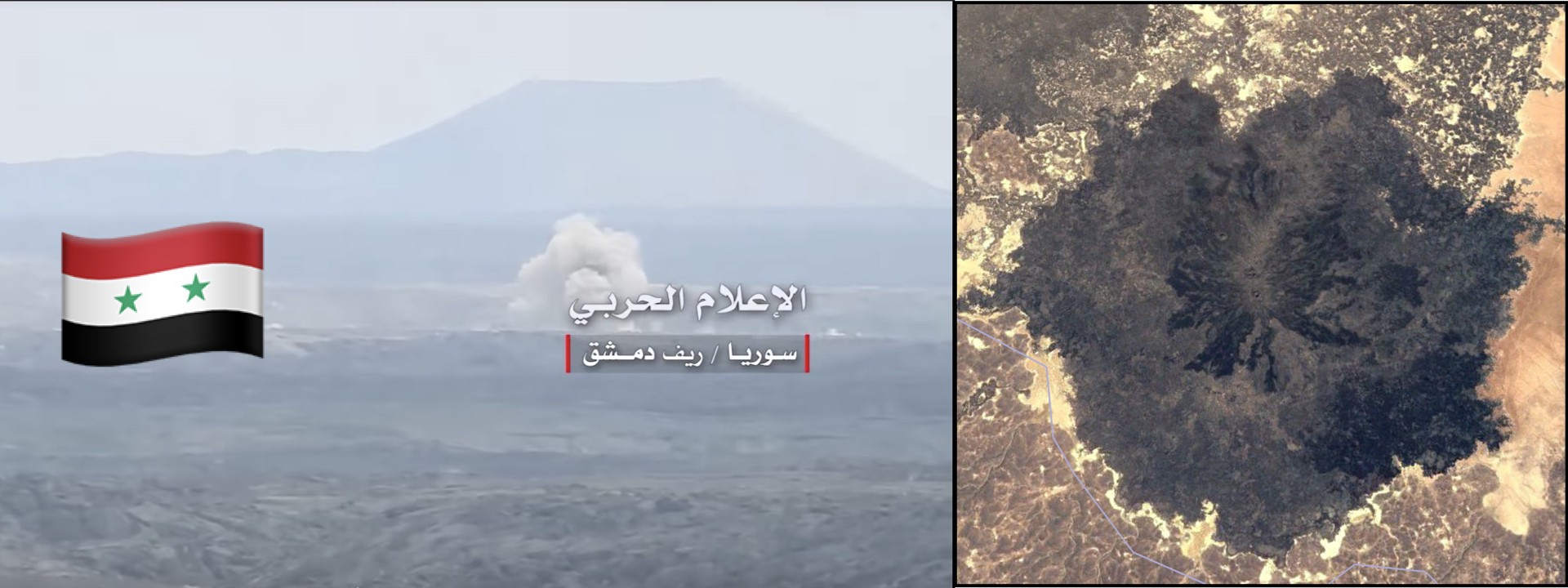#BreakingSyria: The Fall of ISIS’s Volcanic Stronghold
The battle for the Safa volcanic field, one of the last ISIS footholds in Syria, is over
#BreakingSyria: The Fall of ISIS’s Volcanic Stronghold

The battle for the Safa volcanic field, one of the last ISIS footholds in Syria, is over

Assad regime forces captured the volcanic field of Safa, the final piece of one of the last remaining ISIS strongholds in southern Syria, from the insurgent group on November 17, 2018.
After Assad’s Syrian Arab Army (SAA) forced ISIS combatants’ retreat in mid-August 2018. An estimated 1,500 ISIS fighters held Safa (also called Es Safa or Al Safa), a rocky volcanic field near the City of Suwayda (Sweida). In August, SAA encircled the Suwayda region, ultimately freeing it from ISIS after 104 days of intense fighting.
The SAA victory in the Safa field means that Assad now effectively controls the territory south of Palmyra.
Safa Volcanic Field
Safa basaltic volcanic field is a striking plateau of rolling black hills, located to the southeast of Damascus. This landmark is one of its kind in Syria and its distinct features are clearly visible in satellite imagery.

This uninhabitable field of volcanic rocks was one of the last bastions of ISIS fighters in Syria. Due to its rugged terrain, which is inaccessible to armored vehicles, the field served as a stronghold for approximately 1,500 ISIS fighters, who waged a relatively effective guerrilla war against SAA encirclement.

The Last Push
In a November 6 Twitter post from a pro-Assad user, Colonel Ghaith Dalla was identified as the SAA leader undertaking the attack on Safa. Colonel Dalla is the verified Commander of the Al Ghaith forces; he is called the Lion of 4th Mechanized Division; he is known for his leadership in previous operations, including the Al Qaboun offensive last year.
The Al Ghaith group, under the 42nd Brigade of the 4th Mechanized Division of the SAA, is specifically trained for urban combat and counter-insurgency warfare and successfully fought Hayyat Tahrir al‑Sham in late 2017. The Al Ghaith group, together with the 42nd Brigade, was subsequently redeployed to Baath in June 2018 and played a crucial role in breaking the rebel resistance in the southern front.

On November 10, the first videos of artillery shelling in the Safa region appeared. Large numbers of SAA heavy mortars bombarded the entrenched ISIS fighters on the volcanic field. Armored vehicles visible in the video most likely supported the ground offensive from afar, following the indirect fire attacks.
As with most of the available footage, the exact location could not be determined, nonetheless the black terrain and the distinctively shaped Safa volcano visible in the background confirmed that this attack took place in and around the volcanic field.


Additionally, on November 13, the 4th Division’s improvised Golan launchers were recorded pounding the area. Golan rocket systems were historically built on a T-72 chassis. During the conflict, however, several variations of the weapon emerged. These heavy self-propelled artillery systems carry rockets with warheads 500mm in diameter, each filled with 500kg of high-explosives.
S. #Syria: few photos showing 4th Division's "Golan" launchers pounding #Safa Volcanic Field. Pics 3-4: shortly after they arrived & the current situation as large areas are still flooded. pic.twitter.com/lu4739RRda
— Qalaat Al Mudiq (@QalaatAlMudiq) November 13, 2018
S. #Syria: battery of 4th Division launchers shelling #ISIS-held #Safa Volcanic Field w/ improvised "Golan" rockets (IRAM). pic.twitter.com/NS2tkNPGNp
— Qalaat Al Mudiq (@QalaatAlMudiq) November 13, 2018
According to the second video, the direction of the attack was concentrated on the southwestern part of the volcanic field.

On November 12, photos of Russian soldiers in the Safa area surfaced on social media and blogs. As the photos lacked geolocation details, the exact location could not be confirmed. The volcanic rock in the image, however, suggests that the photos were taken in or near the Safa field.
The appearance of Russian troops on the ground suggested the strategic importance of this attack. Despite the fact that these troops were likely not involved in one-on-one fighting, their presence on the field is rather unusual. The Russian military usually supports SAA attacks with indirect fire, aerial support, or Military Police units.

Evidence of Victory
The intense bombardment of the area was soon followed by an infantry offensive. After a few days of fighting, on November 17, the first videos of SAA soldiers recorded on the Safa hills surfaced.
S. #Syria: Assad forces announce full control over #Safa Volcanic Field. Video shot by 61st Brigade shows Volcano is under their control. Sources say #ISIS organized its withdrawal previous nights, only leaving a handful of fighters. pic.twitter.com/XNeFGPbRki
— Qalaat Al Mudiq (@QalaatAlMudiq) November 17, 2018
Another video surfaced on November 19, this time clearly showing a volcanic crater, revealing their advances.
S. #Syria: 61st Brigade on top of #Safa Volcano (secondary crater), following its capture from #ISIS after 104 days of battle. https://t.co/mmTujkYf4G pic.twitter.com/oNuV5lGKbM
— Qalaat Al Mudiq (@QalaatAlMudiq) November 19, 2018
The latter video suggested that SAA soldiers had reached the central area of the volcanic field, successfully pushing out the ISIS militants.

Conclusion
The successful offensive on the Safa volcanic field marked another SAA victory against the rapidly diminishing ISIS forces in Syria.
The total removal of ISIS forces in Syria’s southern and eastern territories would free up additional troops for the SAA and Russian military to concentrate on the remaining northern rebel stronghold of Idlib. Large forces of SAA troops were reported amassing at the borders of Idlib, but, as of now, no major offensive has been initiated by the SAA. With every successful push, Assad is increasingly re‑establishing his regime in Syria.
@DFRLab will continue to monitor significant Russian operations, exercises and military developments.
Follow along for more in-depth analysis from our #DigitalSherlocks.

